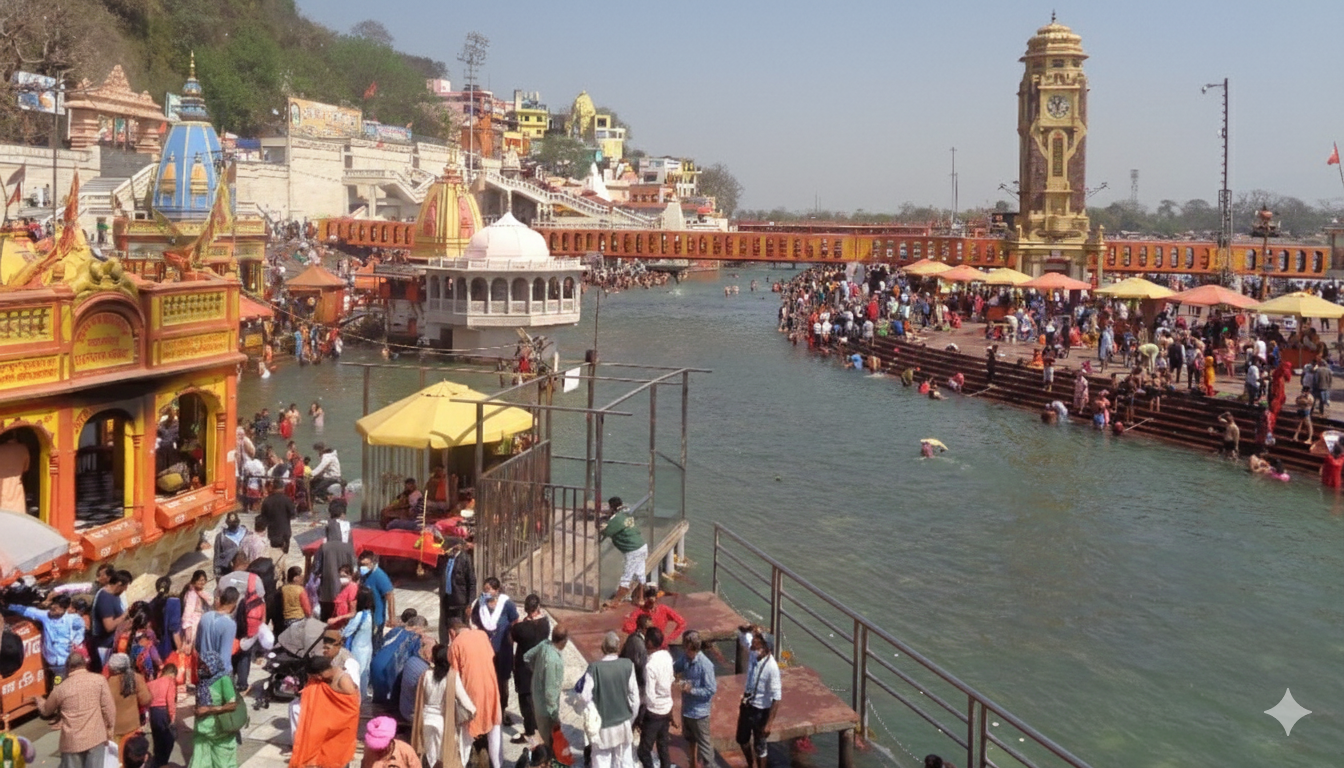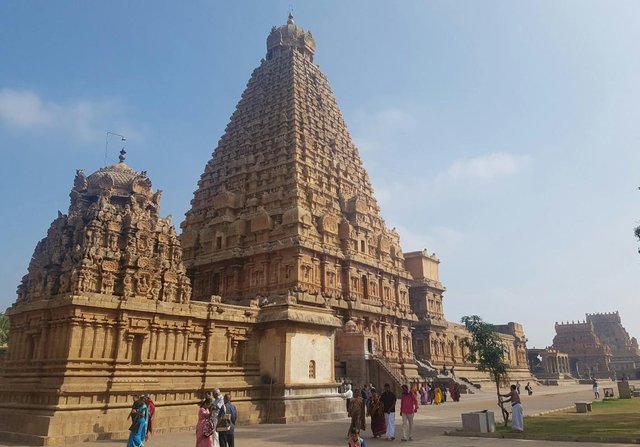Haridwar – The Gateway to Heaven
A place where hundreds of people flock every day with a common hope of Moksha for the departed souls of their loved ones. A scene where a ritual evokes poetic thoughts through the sight of thousands of tiny oil lamps floating on the river against fading evening lights. A land where the holy river turns small before a sea of devotees during the grand festival that comes once every twelve years. This divinely chaotic place is known as Haridwar.

The Land of Gods
Situated on the foothills of the mighty Himalayas, the presence of the holy river Ganga flowing through Haridwar makes this place even more sacred. The state of Uttarakhand is also known as the Land of Gods due to the presence of some of the most divine temples located in the toughest terrains of India. The mighty Himalayas and the holy rivers like Ganga and Saraswati make this state not only spiritual but also one of the most beautiful destinations for any traveller.
Haridwar is around 220 km from Delhi in Uttarakhand’s Dehradun district. Symbolically known as the Gateway to Heaven, Haridwar is one of the most revered cities and serves as a base for several famous temples in the state.
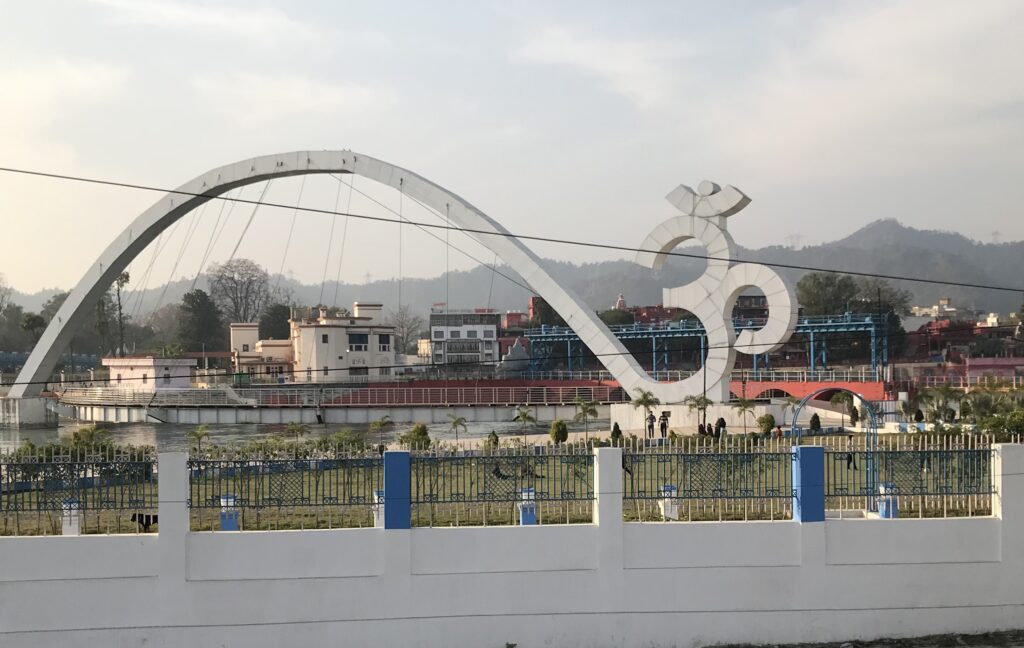
Haridwar - A Perfect Weekend Pilgrimage
A trip to Haridwar combined with nearby Rishikesh makes a perfect weekend itinerary. Due to its proximity to Delhi and its excellent road connectivity with frequent bus services, this small town on the banks of the sacred river Ganga always appears busy. Like in Kashi, the Ganga River holds a predominant place among the devotees who throng the ghats and temples associated with it.
A dip in the Ganga is believed to relieve all sins accumulated in one’s lifetime. Many devotees also come to perform rituals (poojas) for the departed souls.
The Morning at Har Ki Pauri
If the mornings at Haridwar are filled with devotees performing rituals, temple darshan, and taking holy dips in the river, the evenings transform into a grand celebration at Har Ki Pauri, where hundreds gather to witness the famous Ganga Aarti — a 45-minute offering to Goddess Ganga.

My first visit to this holy city was during a weekend trip with some relatives. A comfortable evening drive from Delhi allowed us to start exploring Haridwar early the next morning after a sound sleep. Visiting temples in the morning usually has advantages of less crowd and more comfort — but not here. As we crossed the bridge towards the main temple and ghat area, we were met by an overwhelming crowd filling the walkways, ghats, and temple premises.
Steps to Shiva
The main temple in Haridwar, located on the banks of the Ganga River, is known as Har Ki Pauri, meaning Steps to Shiva. It is considered the most divine spot in Haridwar, drawing lakhs of devotees from across India. Foreigners too become part of this sacred gathering, eager to experience Indian spirituality on the river’s edge.
Along with Kashi, this temple is renowned for rituals performed for the departed souls to attain Moksha, symbolically sending them into the safe hands of the Gods.
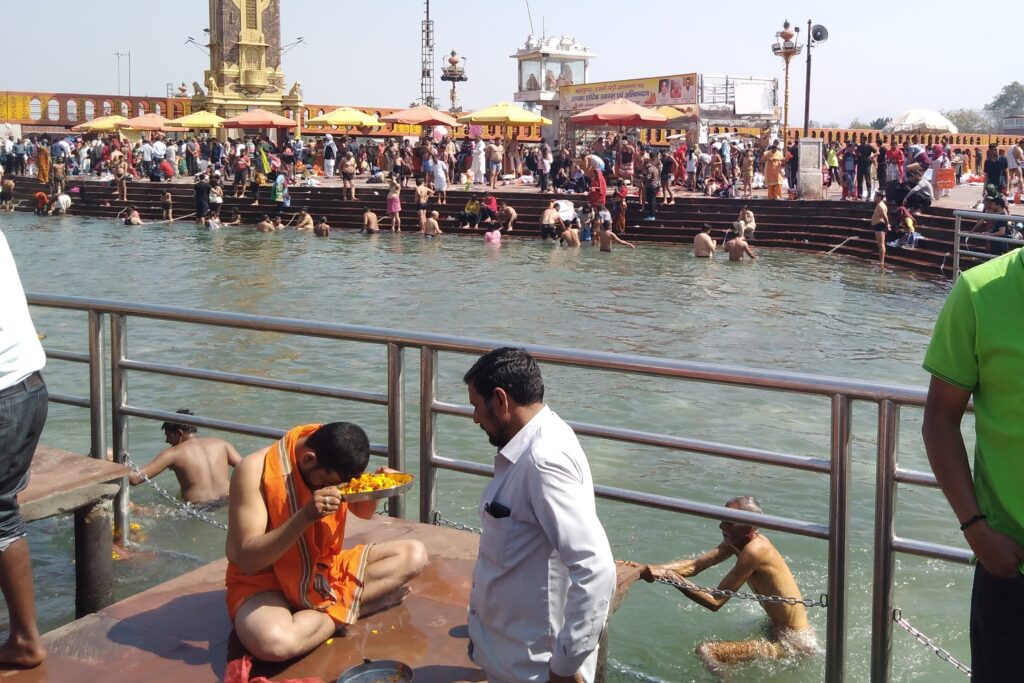
Many come to immerse ashes in the river or perform Pinda Dan, a yearly ritual for the departed souls similar to the Karkkidaka Vaavu Bali observed in Kerala. After our prayers and temple visit, we descended just a few steps to the ghat — a heavily crowded area where people waited their turn to perform various rituals or simply absorb the divine atmosphere.
As my father had passed away a year earlier, I too performed a pooja in his memory. The river’s flow was powerful after recent rains — so strong that even dipping a foot in the water for a few seconds was impossible. Local safety arrangements included chains tied to handrails for devotees to hold on to while performing their rituals.
We spent some time on the ghats, silently watching hundreds of Indians — transcending class and caste — praying together for a common hope: that the souls of their loved ones might find peace and Moksha in the abode of the divine.
Mother Ganga – The Living Goddess in Haridwar
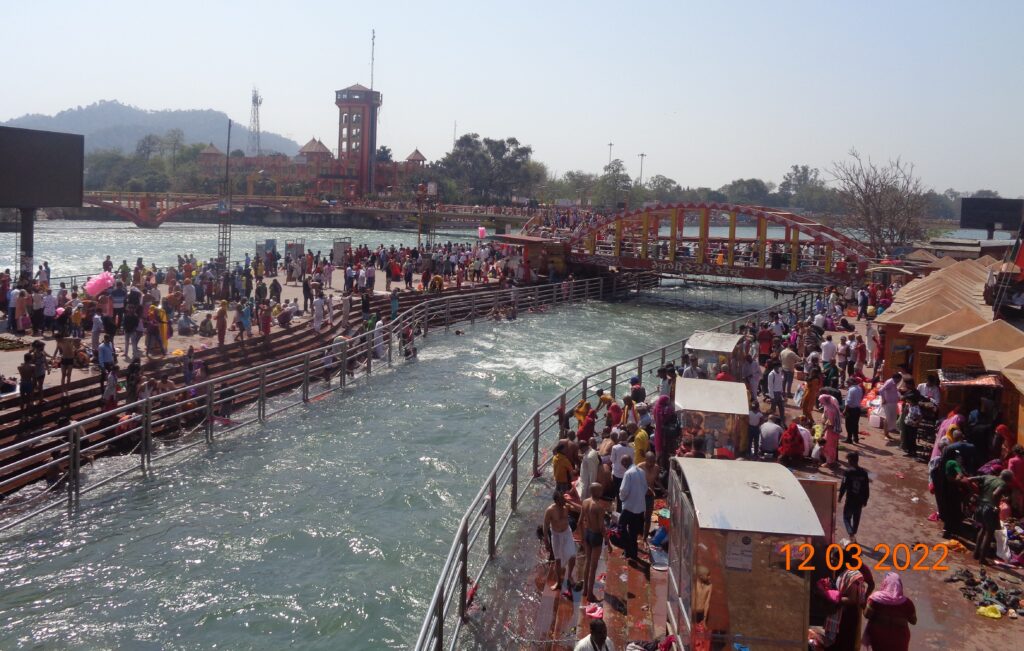
Beside Har Ki Pauri stands another temple, Ganga Mandir, dedicated to Mother Ganga herself. According to Hindu belief, the river is not just water but a living Goddess. The famous Ganga Aarti is a ritual of offering prayers to her. Originating from the Himalayan glaciers about 300 km away, the Ganga touches the plains of India at Rishikesh, near Haridwar.
Though the area was calm during our visit, it was clear that by evening, this entire stretch would transform into a festival-like atmosphere for the Aarti. The sight of hundreds of oil lamps floating on the river, reflecting the glow of giant fire lamps held by priests in the fading light of dusk, is beyond words — an experience that must be seen to be believed.
We decided to return in the evening to witness this grand ritual.
Journey to the Hills – Mansa and Chandika Devi Temples

Being part of Uttarakhand, a state where nearly 80% of the terrain is hilly, Haridwar too is surrounded by mountains. On either side of the river, one can see ranges of varying heights. Two famous temples — Mansa Devi and Chandika Devi — sit atop these hills, about 5 km apart. Visitors can reach them either by trekking or by ropeway cars. The authorities offer a combined ticket for both temples, with a bus service connecting them.
Mansa Devi – The Goddess Who Grants Wishes
We first visited Mansa Devi Temple, situated on Bilwa Parvat of the Shivalik Hills — the southernmost chain of the Himalayas. Dedicated to Goddess Mansa Devi, whose name literally means “wish,” the temple is believed to grant the heartfelt wishes of devotees. A sacred tree inside the temple is adorned with threads tied by devotees after making a wish; once fulfilled, they return to untie the thread as a gesture of gratitude.
The ropeway ride offered a breathtaking view of Haridwar — the temples, ghats, streets, hotels, and the winding Ganga below framed by towering mountains. Every moment of the short journey upward was visually captivating.
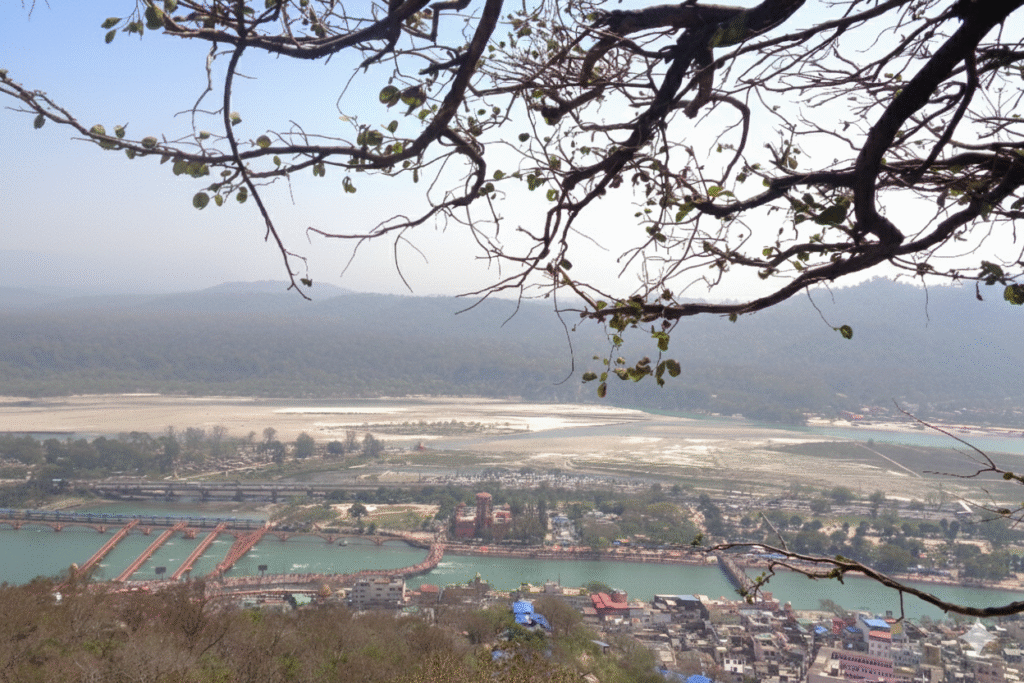
Chandika Devi – The Protector Goddess
After our darshan, we boarded the free bus to the opposite hill, Neel Parvat, to visit Chandika Devi Temple, located about 4 km away. This temple, one of the oldest and most revered in Haridwar, is also part of the Panch Tirth (Five Pilgrimage Sites). Believed to have been established by Adi Shankaracharya in the 8th century, the temple attracts long lines of devotees.
From the ropeway, the view was entirely different — lush green hills, dense forests, and glimpses of the shimmering Ganga far below. Nearby was another smaller temple dedicated to Anjana Devi, the mother of Lord Hanuman — a rare and interesting find, especially for visitors from southern India.
By the time we returned, it was afternoon. After lunch and a brief rest, we headed back to Har Ki Pauri for a holy dip and to witness the much-awaited Ganga Aarti.
A Dip in the Holy Ganga
Taking a full dip in the sacred Ganga is believed to wash away one’s sins — both known and unknown. Standing in the river’s strong current, fully immersing the body three times, felt like a deeply cleansing experience. Somewhere within, a quiet voice whispered that perhaps the belief carried more truth than imagination.

With renewed energy and a cup of hot tea, we made our way to find a good spot for the Aarti. Every available space around the ghat was already filling up long before the ceremony began. We managed to secure a place on the opposite bank, from where the view was perfect.
The Evening Ganga Aarti – A River of Light and Faith in Haridwar
As dusk settled, priests took their positions on raised platforms along the ghat. Facing the river, they performed the sacred rituals with large brass lamps, incense sticks, camphor, and chants in unison. The synchronization of their movements, the rhythmic sound of bells, and the collective chanting of devotees created an aura of devotion that words can hardly capture.
For 45 minutes, time seemed to stand still. The Ganga glowed with the reflection of fire lamps, chants echoed through the air, and hearts across the banks beat to the same rhythm of faith.
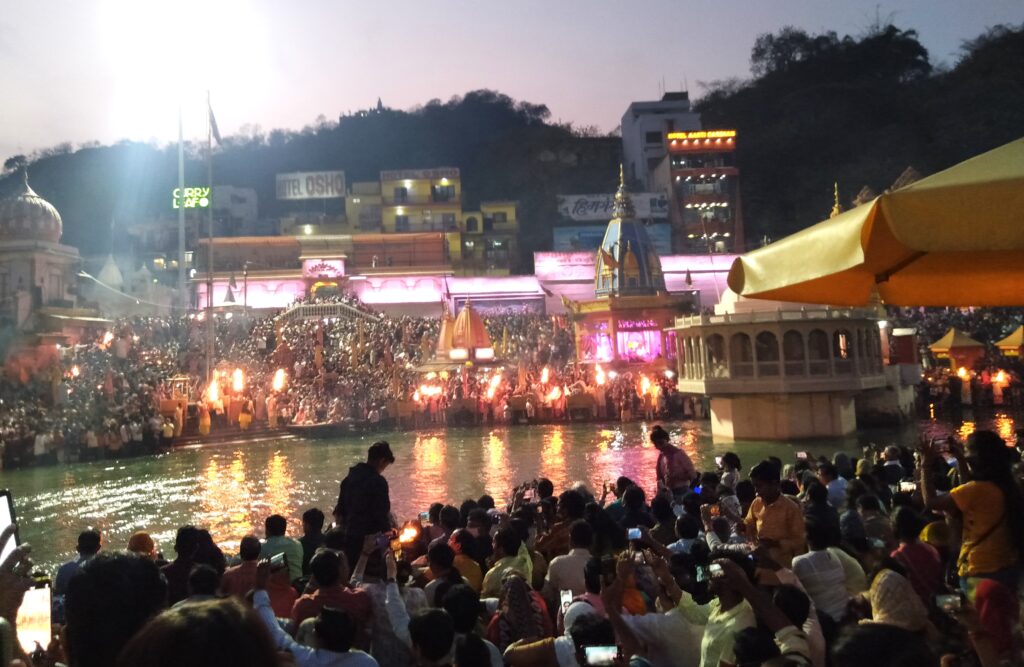
As the Aarti concluded, people began placing small leaf boats carrying oil lamps, flowers, and incense into the river. One by one, the diyas floated away, creating a glittering trail on the dark waters — a sight so enchanting that it felt like watching countless prayers drift toward the divine.
We too placed our lamps on the flowing river, marking the perfect end to a spiritually fulfilling day in Haridwar.
Beyond Haridwar – The Pilgrim’s Path
Being in the Land of Gods, Haridwar holds immense divine significance as one of the starting points of the Char Dham Yatra — the pilgrimage to Kedarnath, Badrinath, Gangotri, and Yamunotri. The city also hosts the world-famous Kumbh Mela every 12 years, attracting millions of pilgrims from across the globe.
Today, Haridwar is equally known for the headquarters of Patanjali Yogpeeth, founded by Baba Ramdev, continuing its legacy as a centre of faith, wellness, and devotion.
Continue your journey along the sacred River Ganga — click here to discover Kashi, the timeless city of temples.
Click here for Wikipedia details on Haridwar
TRAVEL INFORMATION
📍 Location
Haridwar, one of the holiest cities in India, is located in the Dehradun district of Uttarakhand, at the foothills of the Shivalik range of the Himalayas. The sacred river Ganga enters the plains for the first time here, making it a major pilgrimage destination for Hindus.
- State: Uttarakhand, India
- District: Dehradu
- Distance from Delhi: Around 220 km by road
🚗 How to Reach
By Air
- The nearest airport is Jolly Grant Airport, Dehradun (DED) — about 35 km from Haridwar.
- Regular flights operate from major cities like Delhi, Mumbai, and Bangalore.
- Taxis and buses are easily available from the airport to reach the city.
By Train
- Haridwar Junction (HW) is a major railway station connected to cities such as Delhi, Kolkata, Mumbai, Jaipur, and Varanasi.
- Frequent express and passenger trains make it convenient for travelers from across India.
By Road
- Haridwar is well connected by national highways.
- From Delhi, the drive takes around 5 to 6 hours (NH334) via Meerut, Muzaffarnagar, and Roorkee.
- Regular buses operate from Delhi’s ISBT Kashmere Gate, as well as from Rishikesh, Dehradun, and other nearby cities.
🕰️ Best Time to Visit
October to March (Winter & Early Spring)
- Pleasant weather for temple visits, sightseeing, and attending evening Ganga Aarti.
- Ideal for short pilgrimages and weekend getaways.
April to June (Summer)
- Slightly warm but manageable, especially during early mornings and evenings.
- Suitable for visiting Mansa Devi and Chandi Devi temples via ropeway.
July to September (Monsoon)
- Heavy rains may cause the river to swell, making certain ghats risky.
- However, the lush green hills around Haridwar look stunning during this time.
Special Events
- Kumbh Mela – Once every 12 years, attracting millions of devotees.
- Ardh Kumbh Mela – Every 6 years.
- Kanwar Yatra (July–August) – Pilgrims carry Ganga water to offer at Shiva temples.
🧳 Travel Tips
- Carry Light: As Haridwar involves walking through crowded ghats and temple lanes, carry only essentials like water, wallet, and camera in a small sling bag.
- Dress Modestly: Since it’s a deeply religious city, modest and comfortable attire is advisable. Light cottons work best for most of the year.
- Footwear: Many temples and ghats require you to leave footwear outside, so wear something easy to remove.
- Safety Near River: The Ganga’s flow can be deceptively strong—use railings or chains where provided and avoid deep areas.
- Photography: Photography is allowed in most areas, but be respectful of rituals and devotees. Avoid using flash during Aarti or temple poojas.
- Stay Hydrated: The weather can get dry even in cooler months; bottled water is easily available everywhere.
- Cash & Connectivity: ATMs are present, but mobile networks may fluctuate during peak crowd times or festivals.
🏨 Where to Stay
Haridwar offers a range of accommodations from spiritual ashrams to modern hotels:
- Luxury Options: Ganga Lahari, Haveli Hari Ganga, Radisson Blu Haridwar – for a comfortable and scenic stay near the ghats.
- Mid-Range: Hotel Alpana, La Casa Hotel, Hotel Trishul – good value, close to Har Ki Pauri.
- Budget & Ashrams: Bharat Sevashram Sangha, Shantikunj Ashram, and several dharamshalas – ideal for those seeking a peaceful, spiritual atmosphere.
🪔 Tip: Staying near Har Ki Pauri gives the best access to morning temple visits and the evening Ganga Aarti on foot.
📸 Best Photography Spots
- Har Ki Pauri Ghat: For the magical reflection of flames on the water during Ganga Aarti.
- Ropeway Ride to Mansa Devi: Capture panoramic views of Haridwar town and the Ganga winding through it.
- Chandi Devi Temple Hill: Ideal for sunrise or sunset shots over the river.
- Bridges & Ghats: The pedestrian bridges offer symmetrical frames of devotees, lamps, and the flowing Ganga.
- Street Scenes: Early morning or post-Aarti, the bustling lanes around Har Ki Pauri offer candid shots rich in culture and emotion.
✨ Closing Thought
A visit to Haridwar isn’t just a trip—it’s an experience that touches both the spiritual and visual senses. The sound of temple bells, the sight of flickering lamps floating away in the Ganga, and the faith that binds thousands together make this city a reminder that divinity often resides in simplicity.

